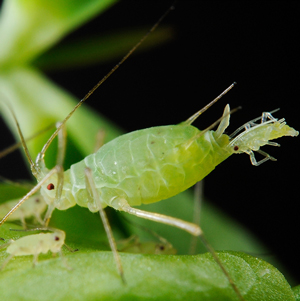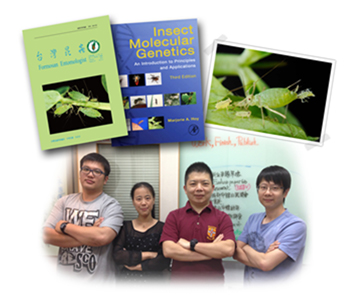

 |
||
|
::: NTU’s Research on Aphid Reproductive System Continues to Make International Impact |
||
|
National Taiwan University’s research on aphids, a sap-sucking insect that feeds on cultivated plants, has garnered widespread attention and recognition as our breakthroughs have already made the covers of three major international journals in the first half of 2014. As aphids are one of the most common and destructive insect pests that threaten agricultural production, NTU’s research contributes to aphid pest control and management. Aphids are hemipteran insects that live on host-plants by sucking the plants’ sap while at the same time spreading viruses as they feed. Leader of the Department of Entomology research team, Professor Chun-Che Chang (張俊哲), points out that as aphids can reproduce asexually, female aphids sometimes give birth to young female aphids that are, before they are born, also ready to reproduce. This, according to Chang, allows for massive and rapid reproduction. Added onto the fact that aphids transmit viruses from plant to plant, aphids pose an extended threat to the global food crisis.  Aphids can reproduce asexually and give birth to large amounts of young aphids during their life cycle. (Photo: Department of Entomology)
The NTU research team, as a result, has been studying the aphid’s reproductive genomic model with the aim to establish the insect as a model organism so as to facilitate basic and translational agricultural research for a better understanding of developmental diversity and biological knowledge. In the 2014 June edition of Insect Science, for example, the team published a major breakthrough in gene detection technology that, according to the paper’s first author Chen-Yo Chung (鍾成侑), established the aphid as a developmental model organism. This achievement served as an important milestone in pushing the team further into reaching its goal. In addition, EvoDevo’s May publication, which featured the team’s study on aphid reproductive germ cells, overthrew a century-long conjecture in being the first to scientifically prove that aphids have replaced their gradual metamorphosis with complete metamorphosis.  The Department of Entomology aphid research team led by Prof. Chun-Che Chang (2nd, right) is dedicated to uncovering the pest’s reproductive genome system. Another exception to previous assumptions occurs in the aphid’s anterior axis. Student Yi-Min Hsiao (蕭逸旻) points out that the research team found that the aphid’s caudal gene differs from patterns common to other insects in that not only is it not shown in early stages of development, the caudal also shows different development signs to the anterior "hunchback" genes. This unusual expression pattern proves that asexual (viviparous) reproduction by female aphid differs from that of the existing insect models. This important discovery was published in the leading entomology journal, Insect Molecular Biology 2014. One of the images presented in the paper was also featured as the journal’s 2014 cover. In addition to being featured in acclaimed international journals, the team’s research has also received attention from local publications such as Insect Molecular Genetics and Formosa Entomology. Related Articles: “New Milestone in Molecular Agriculture: Publication of the whole genome sequence of the pea aphid” (03/01/2010) |
||
No. 1, Sec. 4, Roosevelt Road, Taipei, 10617 Taiwan(R.O.C.)
Phone: +886-2-3366-3366 Fax: +886-2-2362-7651